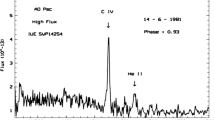Abstract
We analyzed the spectra of eight T Tauri stars (T Tau, RY Tau, CO Ori, EZ Ori, GW Ori, GX Ori, V1044 Ori, and SU Aur) in the wavelength range from 1200 to 3100 Å taken with the STIS spectrograph from the Hubble Space Telescope. For each star, we found an upper limit on the interstellar extinction A v , which proved to be lower than the values obtained by different authors from optical observations. For T Tau and RY Tau, we found the upper limits on their luminosities, masses, and radii as well as the bolometric luminosity of the excess emission continuum. The latter is most likely associated with mass accretion from a protoplanetary disk. We show that the bulk of the emission continuum is radiated in the infrared. For these stars, we determined the ratio of the flux in the C IV 1550 doublet lines to the excess-continuum flux. This ratio proved to be two orders of magnitude lower than its values predicted by the accretion-shock (AS ) models developed by Lamzin (1998) and Calvet and Gullbring (1998). This result leads us to believe that for T Tau and RY Tau, the emission continuum originates in the accretion disk and/or in the boundary layer rather than in the AS, as has been assumed previously. This implies that in these stars, only a small fraction of the accreted matter passes through the AS, while the bulk of this matter settles in the equatorial plane of the star, passing through the boundary layer.
Similar content being viewed by others
References
C. Bertout, Ann. Rev. Astron. Astrophys. 27, 351 (1989).
R. C. Bless and B. D. Savage, Astrophys. J. 171, 293 (1972).
N. Calvet and E. Gullbring, Astrophys. J. 509, 802 (1998).
M. Cohen and L. V. Kuhi, Astrophys. J., Suppl. Ser. 41, 743 (1979).
F. D'Antona and I. Mazzitelli, Astrophys. J., Suppl. Ser. 90, 467 (1994).
G. Duchene, A. M. Ghez, and C. McCabe, Astrophys. J. (2002) (in press).
J. H. Elias, Astrophys. J. 224, 857 (1978).
M. Gagne, J.-P. Caillault, and J. R. Stauffer, Astrophys. J. 445, 280 (1995).
A. I. Gómez de Castro and M. Franqueira, ESA SP-1205 (Noordwijk, The Neetherlands, 1997).
E. Gullbring, N. Calvet, J. Muzerolle, and L. Hartmann, Astrophys. J. 544, 927 (2000).
L. Hartmann, R. Hewett, S. Stahler, and R. Mathieu, Astrophys. J. 309, 275 (1986).
G. H. Herbig and K. R. Bell, Lick Obs. Bull. 1111 (1988).
W. Herbst, J. F. Booth, P. F. Chugainov, et al., Astrophys. J. Lett. 310, L71 (1986).
C. M. Johns-Krull and J. A. Valenti, Astrophys. J. 561, 1060 (2001).
S. A. Kaplan and S. B. Pikel'ner, The Interstellar Medium (Nauka, Moscow, 1979; Harvard Univ. Press, Cambridge, 1970).
S. J. Kenyon and L. Hartmann, Astrophys. J., Suppl. Ser. 101, 117 (1995).
A. S. Kravtsova and S. A. Lamzin, Pis'ma Astron. Zh. (2002) (in press) [Astron. Lett. (2002) (in press)].
S. A. Lamzin, Astron. Zh. 75, 367 (1998) [Astron. Rep. 42, 322 (1998)].
J. S. Mathis, Ann. Rev. Astron. Astrophys. 28, 37 (1990).
J. Najita, S. Edwards, G. Basri, and J. Carr, in Protostars and Planets IV, Ed. by V. Mannings, A. P. Boss, and S. S. Russell (University of Arizona Press, Tucson, 2000), p. 457.
A. J. Pickles, Publ. Astron. Soc. Pac. 110, 863 (1998).
M. J. Seaton, Mon. Not. R. Astron. Soc. 187, 75p (1979).
M. F. Skrutskie, M. R. Meyer, D. Whalen, and C. Hamilton, Astron. J. 112, 2168 (1996).
R. J. White and A. M. Ghez, Astrophys. J. 556, 265 (2001).
Author information
Authors and Affiliations
Additional information
__________
Translated from Pis'ma v Astronomicheski\(\overset{\lower0.5em\hbox{$\smash{\scriptscriptstyle\smile}$}}{l}\) Zhurnal, Vol. 28, No. 12, 2002, pp. 928–935.
Original Russian Text Copyright © 2002 by Kravtsova, Lamzin.
Rights and permissions
About this article
Cite this article
Kravtsova, A.S., Lamzin, S.A. Analysis of HST ultraviolet spectra for T Tauri stars: Estimating the interstellar extinction and the contribution from an accretion shock to the emission-continuum formation. Astron. Lett. 28, 835–842 (2002). https://doi.org/10.1134/1.1525834
Received:
Issue Date:
DOI: https://doi.org/10.1134/1.1525834




